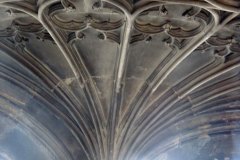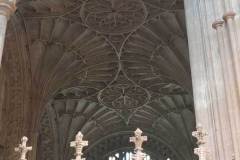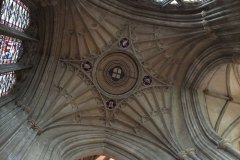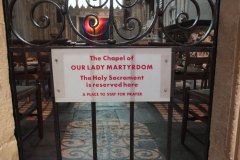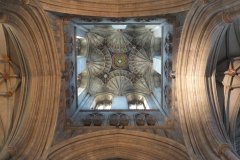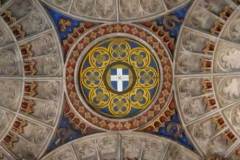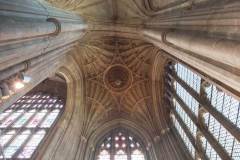Fan vaulting has been praised as ‘one of the great glories of English Perpendicular architecture’ (Leedy (1980)). It emerged during the late Gothic period as a peculiarly English phenomenon. Canterbury cathedral has five impressive examples, including the much admired vaulting of the Bell Harry tower. The distinguishing features of fan vault construction are easier to recognise than to describe. They incorporate a complex geometrical shape known as a ‘conoid’ or cone shape, with circular base, doubly-curved tapering sides and vaulting ribs. They vary in the detail of their design and construction, but all share a striking appeal in terms of their pleasing spatial unity. The earliest example seems to be in the cloister of Gloucester cathedral (about 1350-1412). The best known and most sumptuous is that of King’s College Cambridge (completed by 1515).
The earliest Canterbury example (around 1440) is found in the chantry chapel of Edward the Confessor chapel, which stands close to the tomb of Henry IV. This is difficult to see as the chapel door is closed to the public, but it can be glimpsed through the doorway and window (Image 1).
Two later examples followed in the mid-15th century – the vaulting of Deans’ chapel (around 1455) (Image 2) and that of the south west tower (around 1460) (Image 3). Access to the Deans’ chapel off the Martyrdom (also known as the chapel of Our Lady) is also problematic as the area is reserved for Holy Sacrament and prayer (Image 4). The vaulting can, however, be viewed from the Martyrdom. The south west tower vaulting has a removable central ring through which the great bell named Dunstan (since re-cast and re-located) was raised in 1459.
By far the best known example is the vaulting of Bell Harry tower (around 1505) (Image 5). This also has a removable central circular ring through which the Caen stone and half a million bricks were raised to construct the tower (Image 6). Beside this still stands the two man ‘hamster wheel’ used to power the lift. Those with keen eyesight or binoculars may make out the letters P, T and G designating Prior Thomas Goldstone II, together with his rebus of three gold stones. The nearby bosses show the arms of Archbishop Morton (north east boss), Henry VII (south east), Prior Goldstone II (north west) and Archbishop Warham (south west).
Finally, a fifth example (Image 7) can be seen in the vaulting of the north west tower, rebuilt in the 1830s. This is the only Canterbury example incorporating a (gravity defying) pendant in its centre.

